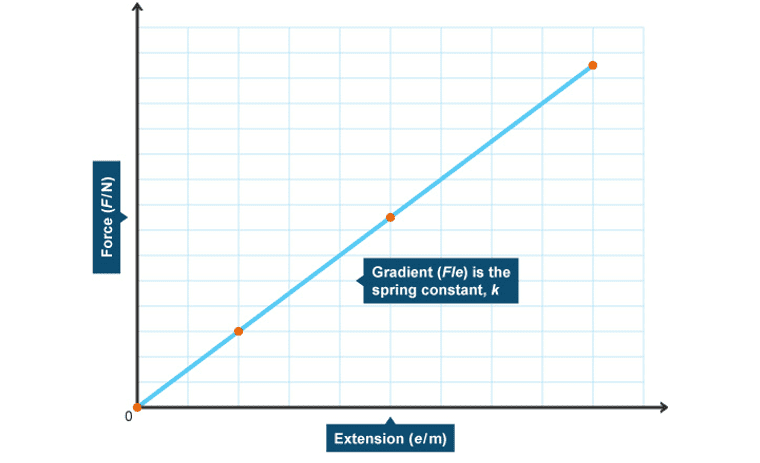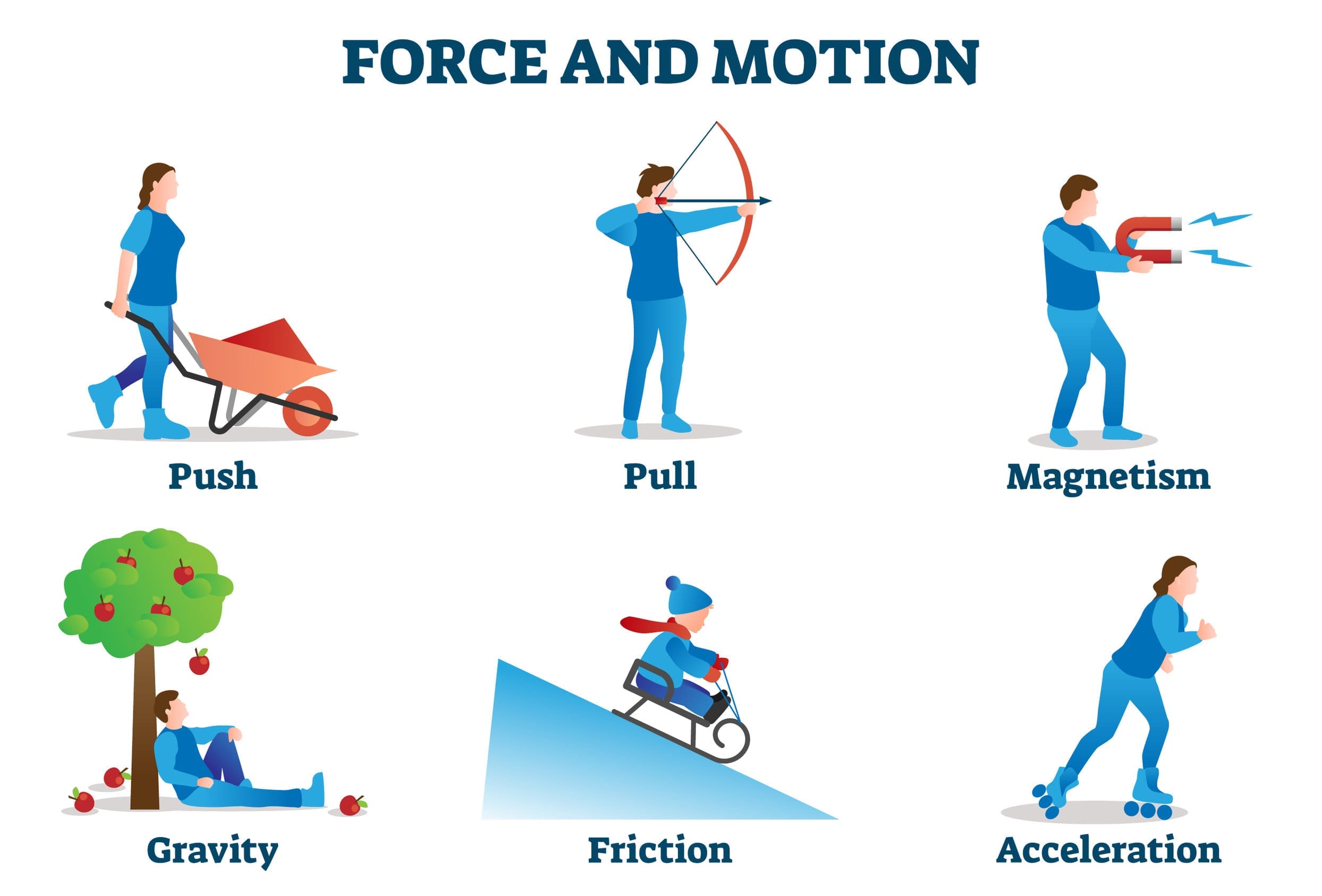In this post
In this section, we will learn how different objects and their size affect the impact of the forces applied to them. Forces are pushes/pulls of one thing onto another. An example of a force is gravity. This is what pulls us to the centre of the Earth and keeps us grounded. In this part of the course we will look at a variety of forces and their effects.
In the image shown below, you can see that the man is pushing the car. Let’s try and identify all the major forces that are involved.

- The man is pushing the car which means he is forcing his mass onto the car.
- The car will not move easily, as there are forces acting on it to stop it from moving. This includes the force of friction between the gear box, the wheels and the car engine, which is unhelpful and opposes the motion of the pushing.
- Another force that is prominent is the pull of gravity towards the Earth. You could call this gravitational force or weight. (If the car were to fall off the edge of a cliff, it would plummet towards the ground – this is the effect of the force of gravity.)
- There is also another force acting on the car which pushes in an upward direction; this is the reaction force from the road.

The unit of force is the Newton (N) and is named after Sir Isaac Newton, who discovered gravity. A force of one Newton will make an object with a mass of one kilogram accelerate at one metre per second squared.
Some other examples of forces are:
- Air resistance/drag – this force acts like friction and tries to oppose the movement of objects through the air. Trains and other fast-moving objects are designed to be more streamlined to try and reduce the effect of this force.
- Up thrust – an example of the effect of this force is the ability of a boat to float on the sea. Although the force of gravity tries to pull the boat down towards the seabed, the force of up thrust pushes upwards against the bottom of the boat to keep it afloat.
- Magnetic forces – these can be used on objects to keep them shut (a fridge door, for example). They can also be used to make motors rotate.
- Electrostatic – an example of an electrostatic force is when you rub a balloon on your clothing and place it near your hair. The hair is attracted to the balloon as it is positively charged with electrostatic forces.
Scalars and vectors
Scalar quantities are those which have only a size associated with them. They have no direction. Examples of scalar quantities include speed, distance, time, power and energy. It is not just the size of the force that is important, but it is the direction in which the force is acting that is also vital. Forces are vector quantities because the size of the force and the direction in which it is acting influence the movement of the object. Forces have both a size and a direction. There are six vector quantities in total. These are acceleration, displacement, velocity, forces, weight and momentum.
The effects of forces
Resultant forces between objects can result in changes to the speed, shape or direction of one or both of the objects.
In the photo we saw earlier, the man is trying to push the car. If the force that the man is using to push the car forwards is the same size as the force of friction that stops the car from moving, he will be unable to move the car. The effects of the forces cancel each other out and result in a net force of zero Newtons, because the two forces have the same magnitude (size) and are acting in opposite directions.
If the man was to ask someone to help him push the car, the forward pushing force would increase. Both forces pushing the car would act in the same direction, so you can find the total forward force by adding them together. For example, if both people were pushing with a force of 200 N the total forward force would be:
![Rendered by QuickLaTeX.com \[ \text{Total forward force} = 200N + 200N = 400N (N = \text{Newtons} \]](https://b3801007.smushcdn.com/3801007/wp-content/ql-cache/quicklatex.com-1ec5db7c4ee83056ad8a4d8fa689f78d_l3.png?lossy=2&strip=1&webp=1)
The forward force from the pushing and the force of friction are all acting along the same line. This means we can find the resultant unbalanced force. As we have learnt, force is a vector quantity so we need to consider the direction in which the force is acting.
In this example, we can think of the force from the people as positive, and the opposing force of friction as negative. So, if the force from friction was 200 N, we would have:
![Rendered by QuickLaTeX.com \[ \text{Forward force} - \text{friction} = (200N + 200N) - 200N = 200N \]](https://b3801007.smushcdn.com/3801007/wp-content/ql-cache/quicklatex.com-a3688867928a814027d05280eb56ba71_l3.png?lossy=2&strip=1&webp=1)
Here we have shown the people pushing as being a positive force and friction as a negative to give a total of 200 N of force that results in the car moving.

Here we have shown the people pushing as being a positive force and friction as a negative to give a total of 200 N of force that results in the car moving.
Friction
Friction is a force which opposes motion by causing moving objects to slow down and eventually come to a stop. In cars and trains, this friction allows them to grip the road and tracks so they can accelerate. Some scientists/designers have learnt how to increase or decrease the amount of friction. An example of when they would decrease the amount of friction is in machinery. This would prevent the machine from using more energy than it needs to so that the moving components do not wear out so quickly. An example of when they would increase the amount of friction is in car tyres. This would allow the car to grip the road and make the handling better.
Friction occurs when one solid object rubs onto another. Objects that move through fluids such as liquid/gases can also cause friction. The friction will slow the object down. If the speed of the object increases, the friction will also increase.
Changing shapes
We have learnt that forces can cause objects to move, accelerate and decelerate. However, they can also cause the shape of an object to change. This change may be permanent or temporary. Examples of useful temporary changes include the storage of energy in a coiled spring or an elastic band. Permanent changes can mean that the object is destroyed. An example of a permanent change caused by forces is a bridge that collapses and can no longer carry the weight of moving vehicles and pedestrians.
Temporary changes of shape
Some materials can change shape depending on the amount of force applied to them. For example, an elastic band can be pulled with a force creating tension until it is released and resorts back to its original shape. Another example is a spring, as it can be compressed into a coil but as soon as it is released, it goes back to its original shape. Some materials like metals are more resilient, and need a large amount of force to be applied for them to change.
Springs and wires
Springs are made of a strong metal such as steel or titanium. They are normally coiled and compressed but can also be stretched depending on the force on them. This strength and the potential to be compressed or stretched, makes them suitable for a wide range of uses including mattresses, mass measuring devices and vehicle suspensions.
Springs demonstrate elastic behaviour. This means that when a force is applied to a spring, the spring changes shape, but when that force is removed the spring will recover its original shape.
Robert Hooke was a scientist who was interested in the elastic behaviour demonstrated by springs. He completed experiments where he applied forces to springs of various sizes and materials by attaching a spring to a hook and adding weights to the bottom of the spring. He measured the extension of the spring against the force of weight applied and found that an increase in the weight added resulted in an increase in the extension of the spring. Results from experiments similar to his are shown in the force-extension graph below:

As can be seen from the force-extension graph, Hooke discovered that the extension of the spring was directly proportional to the amount of weight applied to it. This relationship became known as Hooke’s law. However, Hooke’s law can only be applied as long as the spring is not overstretched.
If a spring has too much force applied to it, it becomes overstretched and cannot compress or spring back into its original shape. This point of overstretching is called the elastic limit and once a spring goes beyond this, it will have changed shape permanently. This point would be seen on a force-extension graph as the point at which the line of the graph curves off.



